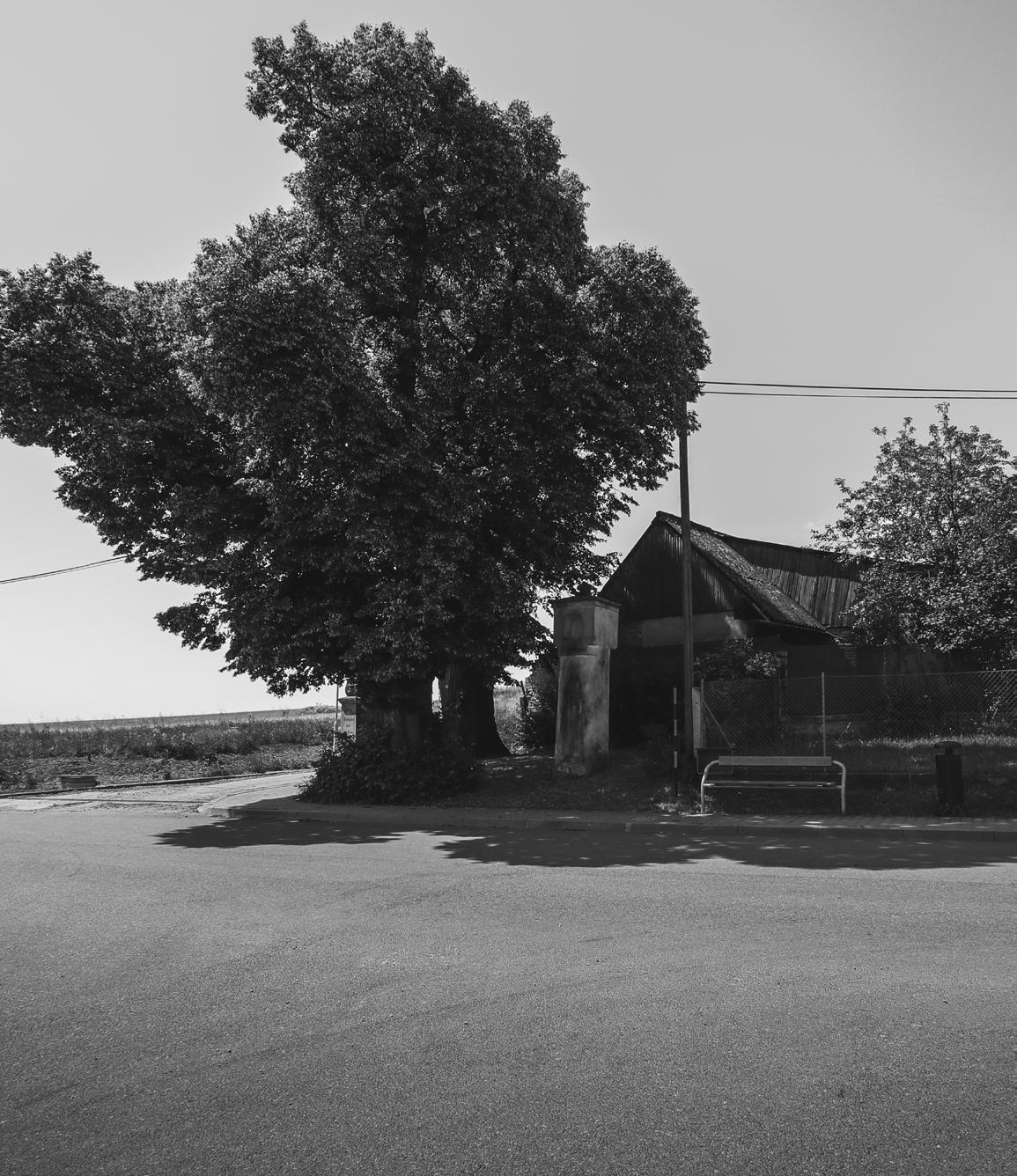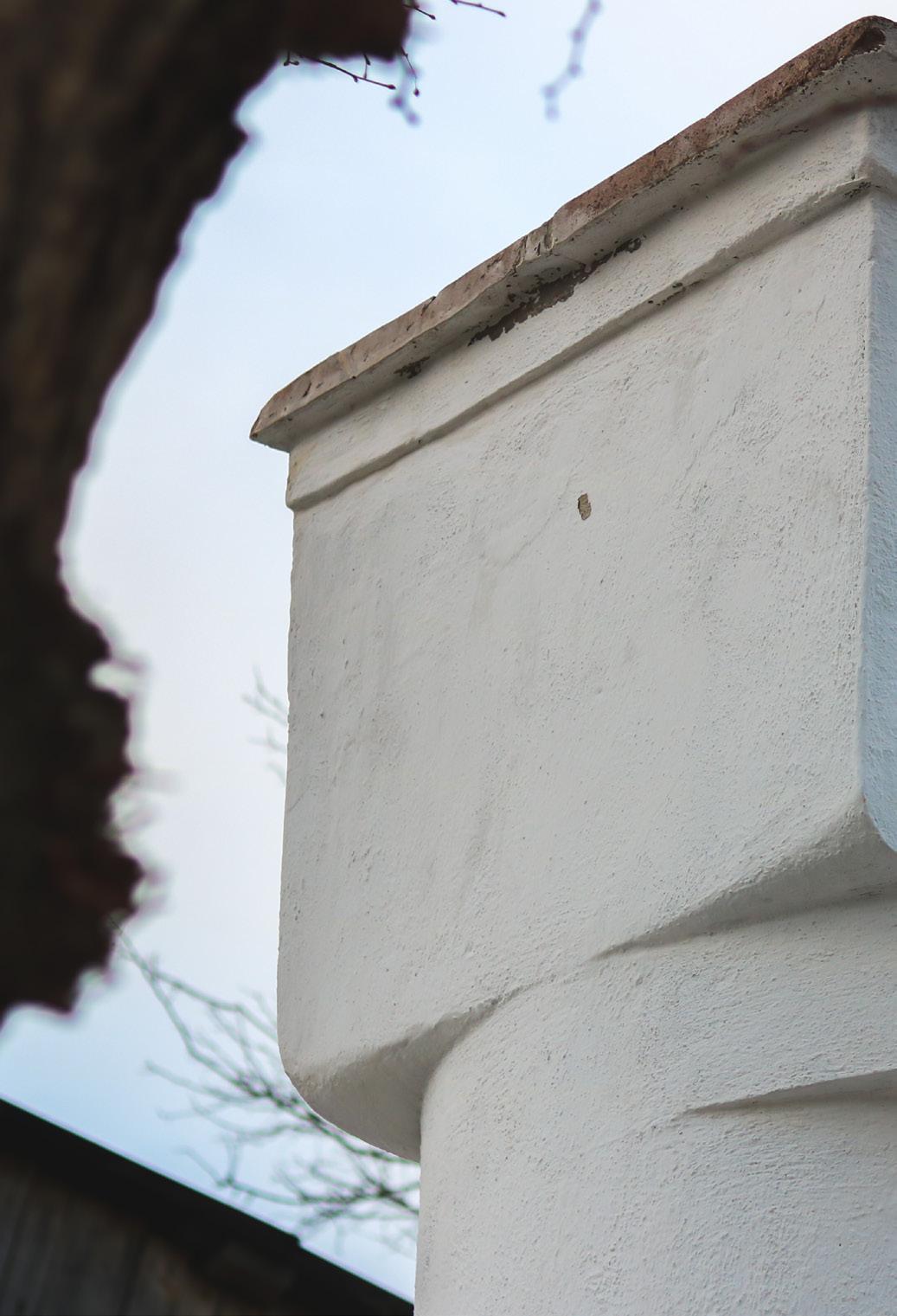
5 minute read
foreword
1 2 3 4 5 6
foreword /11
Advertisement
introduction /24 úvod
sacral landscape /32 krajina duchovní
collective landscape /46 krajina kolektivní
landscape of roads /64 krajina silniční
recovery /78 obnova
exhibition /112 výstava
sources /122
Foreword
10
Mojmír Kyselka
Around seventy years ago, a local peasant was still closely related to the family – parents, children. This wide community also included farm animals, including cats and dogs, as r ural workers with strong family bonds. Therefore, these animals have been personified and given names (e.g. Brok for a dog or Stračena for a cow). Until now, this phenomenon is not considered unusual. However, the fact is that not only those individual beings were part of the wider rural community. Local fields, meadows, forests, ponds and even agricultural pathways have their own personified meaning – a notional face, a name. On the one hand, it could be a pathway with its specific appearance, sometimes related to an event which took place there in the past: A tree or an alley on the hill or a stone at a crossroads. On the other hand, it could be a place of sacred meaning, such
11
12
as a calvary (a chapel dedicated to a saint with a story linking to a particular place where one could stop and contemplate). Until collectivization, the countryside was of a human scale, easy to identify with and with a high level of habitability. In those days, the landscape was available not only for local peasants and the community, but also for outsiders who could come to find peace there. However, this intimate rural setting cannot be re-established now thanks to agricultural holdings which cultivate most of the local lands. In addition to this, water and wind erosion, dry seasons and the need for lower consumption of fossil fuels have led to the situation in which cultivated lands are getting smaller and smaller. An ideal ergonomic optimum of a single flat field’s expanse is meant to be 38.5 ha. Even in these conditions, every detail of the landscape can act as an important point of interest for a human being. One of those is a calvary or a wayside shrine. But what does a calvary or a way-
side shrine mean to the landscape, or to the edge of a village where these structures were usually built? A calvary or a wayside shrine represents the crucifixion of Jesus Christ, who was chained to a circular stone column while being whipped before the actual event of crucifixion took place. That is why the origins of those structures referred to a form of a circular stone column, rarely seen fitted with an iron ring representing the chains. In local conditions, one could spot a heavy Romanesque column made of granite or sandstone which was placed in the landscape without a pedestal but a niche – a space fitted with a statue of tormented Jesus or another saint – a martyr. In the following centuries, a calvary or a wayside shrine was built in the form of a decorated column with a pedestal bearing the load of an epic depiction above. The great significance of the Všechovice Calvary located at the entrance to the village near Kuřim lays in its Romanesque,
13
14
early Christian form. Although the structure likely dates back to a later Baroque period referring to the cult of St. John of Nepomuk, it was designed according to formerly traditional principles, as its shape is a result of the lack of resources in the closest radius of the village at that time. The Všechovice Calvary, together with a huge tree standing nearby gives us the opportunity to sense the respect for our ancestors. This respect was also key to the successful and enthusiastic restoration made by local Scouts from Kuřim. It is a minor, yet important contribution to the question of how to deal with remaining sacral structures located in the agricultural landscape. The majority were destroyed or damaged during the four-decade long era of Communist totalitarianism in our country, which has led to a substantial disruption of almost the entire rural landscape’s character. I wish there were more such enthusiasts who would undertake a restoration of that kind, or even rebuild
these precious structures which belong to the landscape. Moreover, I hope that those Scouts from Kuřim will continue to discover more of these structures – Calvaries, waiting to be rediscovered and restored.
15
16


17
18
Ještě před sedmdesáti, ba šedesáti léty byl náš sedlák – rolník obklopen nejen svojí blízkou – pokrevní rodinou – rodiči a dětmi. K tomu širšímu společenství patřili i další pracovníci na statku, ale přirozeně vše živé – hospodářská zvířata i kočky a pes – a všichni měli svoje jména. Brok a Stračena i další byli členy širší rodiny. Jenže – a to si už tolik neuvědomujeme – širším do jisté míry rodinným společenstvím byly pole, louky, lesíky, rybníky a cesty – a měli svou tvář a své jméno. Trať i místo s důvěrně známým vzhledem a někdy i událostí. Strom, nebo jejich skupina na návrší, kámen na rozcestí, ale pak také to posvátné – k zastavení a zamyšlení – boží muka, poklona, kaplička se jménem světce a příběhem toho místa. Krajina byla až do děsivé, velkoplošné, anonymní kolektivizace lehce identifikovatelná. I v naprostých rovinách lidského měřítka – obyvatelná. Široká rodina krajiny nejen těch, kteří ji obdělávali, ale i těch, kteří si sem přišli odpočinout odjinud než z vesnice.
Ta důvěrnost už se nikdy nevrátí, bude se v zemědělských holdinzích farmařit a jen vodní a větrná eroze, sucho a úspora nafty zmenší pozemky (38,5 ha pole na rovině je ergonomické optimum). A v takové krajině je každý detail záchytným, hluboce lidským bodem. Ale není detail jako detail. Co znamená v krajině, nebo na okraji vsi ojedinělý bod – Boží muka. Název „Boží muka“ pochází od kamenného sloupu kruhového profilu, k němuž byl řetězem připoután Ježíš Kristus, když byl bičován důtkami s kovovými hroty před svým ukřižováním. Právě proto byla nejstarší a nejpůvodnější Boží muka kamenným sloupem oblého tvaru – někdy a dávno dokonce i s železným kruhem pro řetěz. V našich končinách to byly sloupy románské, často žulové nebo pískovcové, těžké a bez podstavce, ale již s nástavbou niky – výklenku pro umístění plastiky zmučeného Ježíše nebo jiného světce - mučedníka. Pak v dalších staletích a stavebních slozích byla Boží muka stavěna jako
19
20
bohatě zdobený sloup se soklem a výpravnou nástavbou. Veliký půvab Božích muk při vstupu do vesničky Všechovice u Kuřimi spočívá právě v té románské – vlastně ranně křesťanské formě. I když pravděpodobně pochází z doby podstatně pozdější – barokní – doby kultu sv. Jana Nepomuckého (ale kdo ví?), zachovává ten nejtradičnější tvar, daný také skromnými možnostmi obce. Všechovická Boží muka, doprovázena mohutným stromem vyvolávají pocit úcty k našim předkům. A ten jistě měli skauti z Kuřimi, kteří nadšeně – laicky – ale s podivuhodně kvalitním efektem tato Boží muka opravili. Je to malý, ale důležitý přínos k pomalé obnově drobných sakrálních památek v naší zemědělské krajině. Ty byly poničeny, ale také zbořeny ve čtyřicetiletém období komunistické totality, která podstatně narušila ráz téměř celé naší zemědělské krajiny. Kéž by se našlo více takových nadšenců, kteří by se ujali obnovy – nebo dokonce znovu výstav-
by těchto drobných skvostů naší krajiny. A snad také kuřimští skauti nezůstanou při jedné takové Boží muce a se svými vedoucími objeví další zchátralou, ale ke vzkříšení připravenou.





